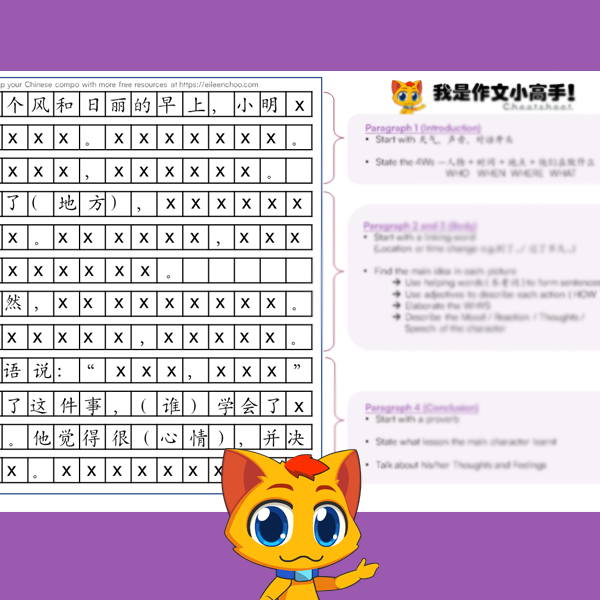
How can you help your child survive Chinese class in Primary 1?
Regardless of whether you have exposed your child to Chinese during their nursery and kindergarten school years, Chinese for Primary 1 will still be a different experience for your child.
In their pre-primary years, Chinese is usually more informal and classes are mostly focused on play. However, when it comes to primary school, you’ll find that Chinese teachers take Primary 1 Chinese more seriously. (Afterall, they need to set the foundation right for your child’s Chinese for the next 5 years.)
As P1 Chinese lessons shift from playing to learning about stroke order, grammar and sentence creation, some children may start to find it a challenge after some time, especially those who come from a non-Chinese speaking family.
To prevent you from the headache of dealing with these later, or spending on Chinese tuition like Berries or Wang Laoshi too soon, let’s see how you can support your child’s learning of Chinese in P1 in a simple, stress-free way.
1. Chinese for Primary 1 is easy because of dad and mum
Your child sees you as a role model and this means that your attitude towards Chinese will mostly affect how they see and think of the language.
The good news is, you don’t have to be the Chinese expert at home or know how to read or explain every Chinese word to your child.
All you need is a positive attitude. Show them that it’s ok to not know a Chinese character and how to find the answer the right way (for example, asking their Chinese teacher or using an e-dictionary). Encourage them to share their Chinese learning experiences and challenges with you.
By showing genuine interest and support, you create a positive learning environment that motivates your child to excel in P1 Chinese.
2. Expose your child to more Chinese-medium activities
The beauty of learning languages lies in not studying, but exposure.
If you’re worried that you have to speak Chinese at home with your child, you don’t have to be the one to do it. Exposure to Chinese can come in the form of introducing interesting cartoons for your child to watch or getting them to listen to songs or stories in Chinese that align with your child’s interests.
Another way to do it is to enroll your child in non-academic classes that are conducted in Chinese (for example, dance classes, drama classes etc.) This is more fun than going for Chinese tuition classes and the bonus? Your child gets to pick up a new life skill or hone their interest. Lahlahbanana has a list of recommendations which I thought is worth a look.

3. Working together with their Chinese teacher
If you start seeing signs that your child is struggling with P1 Chinese, try communicating with your child’s Chinese teacher and get feedback on your child’s progress.
Talking to your child’s teacher can help you better understand the specific challenges that your child is facing in school and let your child’s teacher understand their students better.
4. Understanding the MOE P1 Chinese curriculum
If you prefer a more hands on approach, you can check out what your child is actually learning in school by looking at their Primary 1 Chinese textbook.
You’ll find that the MOE P1 Chinese curriculum takes a thematic approach to learning. At the start of each chapter of the Primary 1 Chinese textbook, you’ll see an overview of all the important Chinese vocabulary words that are associated with the theme (grouped according to level), as well as important sentence structures that can be used for conversation practices. The main content consists of Chinese stories that come with hanyu pinyin to guide your child’s reading.
There are 2 types of Chinese characters that they need to know – “我会认” and “我会写”. The Chinese characters that you see under “我会认” are Chinese characters that P1 kids are supposed to recognise while those under “ 我会写” are the Chinese characters that they need to be able to read and write.
It’s always good to teach your child how to recognise the Chinese characters by using words that come together with them. For example, “师” is “老师”的”师”. As for learning to read and write the characters, you can check out this post that I wrote on Primary 1 Chinese words practice.
5. Explore P1 Chinese resources
Under the 2024 refreshed Primary 1 curriculum for Chinese, schools are using more animated videos, online games and augmented reality during mother tongue lessons for Primary 1.
If you’re looking for more resources for learning P1 Chinese, you can check out the MOE Xue Le website that is available through the SLS Student Portal or my Youtube channel.
Conclusion
Navigating P1 Chinese doesn’t have to be daunting. With the right mindset and proactive approach, you can turn the learning experience into a rewarding journey for both you and your child for the next 5 years of primary school. Share your experiences and insights on how your child is adapting to Primary 1 Chinese in the comments below!






